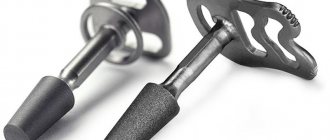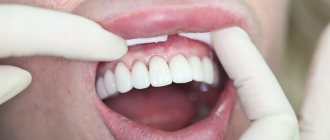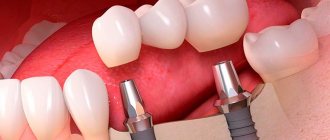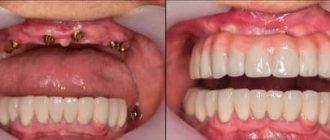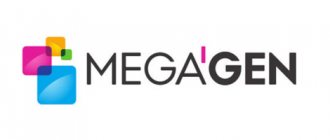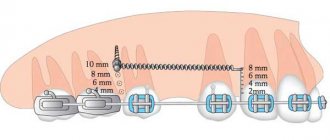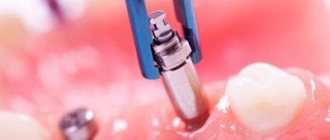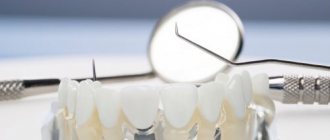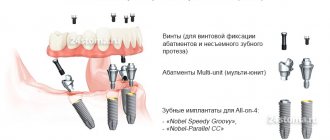All-on-6 dental implantation at the Implantmaster clinic is performed by experienced specialists with a guarantee of 10 years. The price for implantation of the entire jaw using the All-on-6 method on a turnkey basis in Moscow starts from 360,000 ₽.
With a significant or complete absence of natural teeth, patients are faced with the difficult task of going through a painful, lengthy and expensive treatment process that involves the gradual replacement of each lost tooth. Moreover, with a long-term lack of teeth, bone tissue quickly succumbs to loss, which provokes the need for osteoplasty.
All-on-6 implantation, as evidenced by reviews, helps not only to minimize the costs and time required to restore lost teeth, but also eliminates increased tissue trauma during massive surgery.
The Implantmaster clinic employs implant surgeons of the highest category who have solid experience in the use of such unique techniques. In addition, they have in-depth knowledge and skills in working with special software, which eliminates any errors during the implantation procedure and guarantees a prolonged result.
Next, we will provide detailed information regarding the key advantages of this technique and the features of its implementation in practice.
Get a consultation
We will answer all your questions before visiting the clinic!
+7
Online registration
Content
1 What is All-on-6 dental implantation?
2 Pros of All-on-6 implantation
3 Difference between implantation of the entire upper and lower jaw on 6 implants
4 3D implantation planning All-on-6
5 Using a Surgical Navigation Guide for All-on-6 Implantation
6 Type of prosthetics for the entire jaw on 6 implants
7 What implants should be used when implanting All-on-6
8 Stages of the All-on-6 implantation method
9 Disadvantages of All-on-6 implantation
10 Photos before and after All-on-6 implantation
11 Other methods of full jaw implantation 11.1 Trefoil from Nobel Biocare - denture on three implants
11.2 NobelZygoma zygomatic implants – implantation without bone grafting
11.3 Straumann Pro Arch – all on 4-6 implants
11.4 Differences between All-on-4 and All-on-6 technologies when implanting the entire jaw
12 Price of All-on-6 turnkey implantation at Implantmaster dentistry
Disadvantages of the method
The all-on-6 protocol is used for moderate atrophy; its use in acute jaw bone deficiency will not be effective: implants will not be enough to fully support the prosthesis. This is the disadvantage of the technique - its use is limited by the condition of the bone tissue. If you add original Zygoma zygomatic implants from Nobel, the treatment becomes quite expensive.
We not only practice, but also teach others!
Smile-at-Once is an immediate loading implantation university in Russia. We are the only ones who know and apply all methods, and not just one.
More details
| Let's learn from the best and the first! |
| Smile-at-Once specialists receive information only from first-hand accounts. We are an official partner of Nobel Biocare, actively using the products of this brand for the rehabilitation of our patients, so we try to learn directly from the developers of both the brand itself and all implantation protocols with immediate loading, in particular all-on-4. Our doctors have already been trained by Dr. Paulo Malo in Portugal, who is the direct developer of the all-on-4 concept. An exclusive seminar for Smile-at-Once specialists at our clinic was also conducted by Dr. Enrico Agliardi, who is not only a practicing implantologist, but also the head of the department of surgical dentistry at the San Raffaele Hospital (Milan), and a teacher at the Vita Salute University (Milan). He is also a co-developer of the all-on-four protocol. In addition, our specialists regularly undergo training from leading company experts. Thus, at the end of 2022, leading experts from Nobel Biocare in Russia - implant surgeon Georgy Azarin and orthopedic dentist Roman Rozov - conducted an exclusive practical training course for the Smile-at-Once team of doctors. Maximum practice, analysis of clinical cases and details of the use of protocols such as all-on-4, Trefoil and NobelZygoma zygomatic implantation. The Smile-at-Once Clinic is the only specialized center where all complex implantation technologies are used according to immediate loading protocols in Russia. That is why we interact and learn from the best - from direct expert developers, in order to provide treatment at the highest level and keep abreast of the latest developments and nuances. More details |
In addition, six-implant prosthetics must be carried out by professional doctors who not only know how to work with immediate loading methods, but can also plan the treatment process using special software. Otherwise, the installation of implants in conditions of atrophic processes of bone tissue may be carried out with violations, which will result in an increased risk of complications.
What is All-on-6 dental implantation?
The “All on 6 Implants” technique is an improved modern method of restoring missing teeth, which involves the use of six dental implants. Moreover, two of them are fixed in the frontal region, and the remaining four are installed in the area of the chewing teeth. This procedure uses a screw type of fastening and Multi-unit abutments.
The inclined position of the lateral implants helps to select areas with sufficient bone tissue. In this case, the doctor is able to bypass the nerve endings and maxillary cavities located in the immediate vicinity of the implantation site and which are subject to significant risk when implementing the traditional technique.
In the process of the above procedure for prosthetics of the upper jaw, zygomatic implants can be used: two-piece Zygoma. Thanks to their use, it is possible to restore lost units even with a clearly noticeable absence of bone tissue.
This protocol can be used as part of a one-step technique, with simultaneous fixation of dental systems and dentures. That is, a non-removable orthopedic structure can be installed on the third day after surgery. This allows patients to return to their work schedule in the shortest possible time and without long downtime.
Installation of Multi-unit abutments on implants
It is important to remember that when implanting the upper or lower jaw on 6 implants, it is necessary to use exclusively Multi-unit adapters. Classic abutment options are absolutely not suitable in this case.
As mentioned earlier, designs for implementing the All-on-Six technology were created by the manufacturer Nobel Biocare (Switzerland). At the same time, the company presented not only special models of dental implants, but also special Multi-unit transition elements. They are fixed to the implants using screws. Next, a temporary prosthetic device is attached to these adapters, and then a permanent orthopedic structure is attached.
Why are Multi-unit abutments so important when implanting an All-on-6?
As is known, a temporary prosthetic structure will need to be replaced with a permanent prosthesis in the future. In addition, there is a need to periodically clean the orthopedic product. For these reasons, special attention should be paid to the differences between multi-unit adapters and traditional abutments. We'll talk about this later.
Special screws are used to secure multi-unit adapters to implants. In turn, a permanent type prosthetic device is screwed into the body of these abutments. At the same time, when removing the orthopedic structure, there is no need to remove the transition elements from the dental implants.
When traditional connecting components are used, they are removed simultaneously with the prosthetic device, since they do not have their own screw fixation system. This plays a decisive role, since any removal of classic adapters contributes to injury to the biological width of the gingival tissue.
In other words, every time a classic type adapter is removed, the gum tissue around it is damaged. This can provoke the likelihood of inflammatory processes near dental implants and cause active resorption of bone tissue around them. In situations where multi-unit components are used, they remain in the body of the implant during removal of the prosthetic structure. That is, due to their use, all subsequent procedures associated with prosthetics are greatly facilitated, since they are performed in the area located above the border of the gingival tissue.
Pros of All-on-6 implantation
Currently, All-on-6 implantation is popular in many countries around the world due to the following advantages:
- Aesthetic indicators. A fixed prosthesis on 6 implants has a natural appearance that matches natural teeth. In this case, two design options can be used - permanent and adaptive. The period of operation of the adaptive prosthesis can reach 24-48 weeks, after which it is replaced with a more durable and aesthetic permanent bridge. One of the most important advantages of the All-on-6 procedure is the ability to fix a permanent type structure immediately, without the need for further re-prosthetics;
- Shortened treatment period. The entire process of prosthetics, including all necessary studies and fixation of implants using the All-on-6 method, takes no more than three days;
- The versatility of the technique. In dentistry, implants using the “All on 6” technology can be fixed even in the presence of serious pathologies in the area of periodontal tissue. In this case, an obligatory stage of the procedure is the extraction of teeth and cleaning of the sockets, and the installation of dental systems is carried out in the deeper layers of bone tissue, which is not affected by the inflammatory process;
- Low degree of traumatization. When implementing the above described technique, there is no need for osteoplasty. Since implants are installed in harder areas of bone tissue, the All-on-6 procedure in Moscow can be performed even with significant jawbone deficiency. This eliminates the need for massive trauma to the gingival tissue;
- Affordable price. Installing only 6 implants contributes to significant savings in treatment costs;
- Rapid restoration of functional characteristics. The patient becomes able to chew food within the first few days after the intervention and fixation of the prosthesis, and a return to a normal eating schedule occurs within 30-60 days;
- Ease of use and high reliability. The installed orthopedic design does not require special care rules. Moreover, it is easily removed from the oral cavity in dentistry if cleaning or relining is necessary. It should also be noted that the material from which the prosthesis is made can be easily adjusted in the patient’s oral cavity.
What crowns to put
A crown is a cap-shaped structure that is placed on a previously prepared tooth. What does prepared mean? Before prosthetics, the tooth must be cured and the necessary shape created to secure the crown. This restoration method allows you to preserve the part of the tooth that remains intact and not cause harm to neighboring teeth. Restoring a badly damaged tooth with a filling is ineffective: while chewing hard food, it can crack, and along with it, the walls of the tooth can break off. The crown protects the tooth from further destruction and mechanical impact.
Several types of crowns are used to replace the sixth tooth:
- metal;
- metal-ceramic;
- from zirconium dioxide.
In rare cases, ceramic crowns are placed on chewing teeth.
However, we do not recommend doing this, since such crowns are very fragile and may not withstand heavy loads. Crowns differ in appearance and characteristics Table 1. Types of crowns
| Type of crown | Appearance | Advantages | Flaws |
| Metal | Strong and durable, do not require heavy turning, inexpensive | Poor aesthetics, gives a metallic taste in the mouth | |
| Metal-ceramic | Durable, since the frame is made of metal, more aesthetically pleasing than metal crowns | Requires strong grinding, the metal edge can show through the gum and can stand out against the background of natural teeth | |
| From zirconium dioxide | Highly aesthetic (impossible to distinguish from natural teeth), very durable, color retaining, hypoallergenic | They are more expensive than metal-ceramic crowns and are not suitable for restoring teeth in the smile area | |
| Ceramic | Maximum aesthetic (impossible to distinguish from natural teeth), retain color, hypoallergenic | Not suitable for restoring chewing teeth |
When choosing a material for a crown, the following conditions are taken into account:
- how damaged the tooth is;
- how important is aesthetics;
- how strong are the walls of the teeth;
- budget and patient wishes.
Based on the answers to each item listed, the doctor develops a treatment program.
Our team of doctors
Maxillofacial surgeon, Implantologist
Bocharov Maxim Viktorovich
Experience: 11 years
Dental surgeon, Implantologist
Chernov Dmitry Anatolievich
Experience: 29 years
Orthopedist, Neuromuscular dentist
Stepanov Andrey Vasilievich
Experience: 22 years
Endodontist, Therapist
Skalet Yana Alexandrovna
Experience: 22 years
Orthopedic dentist
Tsoi Sergey Konstantinovich
Experience: 19 years
Dentist-orthodontist
Enikeeva Anna Stanislavovna
Experience: 3 years
Features of prosthetics
This is perhaps the most pleasant moment in the entire treatment process. The installation of the prosthesis will be carried out within a few days after implantation, and in a good situation even after 4-5 hours! A fixed orthopedic system is developed at the computer planning stage. A short pause between implantation and fixation of the prosthesis is necessary for the restoration of gum tissue and subsequent assessment of the primary stability of the structures.
Installation of implants
The prosthesis is an individual metal frame with acrylic gum imitation and plastic teeth. To fix the system, small screws are used, which are installed through the crowns into the abutments. A composite material is applied on top. When the prosthesis is loaded, bone tissue cells begin to grow rapidly. For this reason, during the healing of implants there is often a need to reline the orthopedic system. A permanent prosthesis can be installed within six months to a year after implantation, or after 3-5 years, when it fails.
However, today many clinics offer to install a permanent prosthesis right away - instead of plastic crowns, they use artificial teeth made of ceramic composite. Of course, such prosthetics will cost a little more, but you won’t have to change them for at least 10 years.
Difference between implantation of the entire upper and lower jaw with 6 implants
This protocol can be implemented in practice using the following two methods:
- In the lower jaw: the bone in this area is of higher quality and is less susceptible to loss. Moreover, there are no maxillary cavities, which greatly simplifies the procedure for fixing dental implants. This means that a traditional technique can be used in the lower jaw area - two-piece models are installed, which uses a screw fixation method and special Multi-unit abutments. If there is a significant absence of bone tissue in the lateral area, implants can be implanted at a certain angle;
- In the area of the upper jaw: in this case, there is a more massive loss of bone tissue. Consequently, the requirements for the number and size of dental units are increasing. That is, as part of the “All on 6 Implants” program, zygomatic models of 2, 4 and 6 pieces can be used. This allows the technology to be used even in the absence of significant bone tissue.
How much does it cost on average in Moscow?
Prices for economy, business and premium implants (in rubles):
| № | Brand of implant | Economy | Business | Premium |
| 1 | Alpha Bio | 15000 | 20000 | 25000 |
| 2 | Dentium | 15000 | 20000 | 30000 |
| 3 | M.I.S. | 17000 | 20000 | 23000 |
| 4 | BioHorizons | 25000 | 30000 | 35000 |
| 5 | Ankylos | 30000 | 35000 | 40000 |
| 6 | XIVE | 30000 | 40000 | 50000 |
| 7 | Astra Tech | 50000 | 60000 | 70000 |
| 8 | Nobel Biocare | 50000 | 60000 | 70000 |
| 9 | Straumann | 50000 | 60000 | 70000 |
Implantation by stages: economy, business, premium class:
| № | Type of work | Economy | Business | Premium |
| 1 | Anesthesia | 500 | 700 | 1000 |
| 2 | Bone grafting | 15000 | 20000 | 30000 |
| 3 | Implantation of 1 tooth | 15000 | 20000 | 30000 |
| 4 | Abutment installation | 10000 | 15000 | 20000 |
| 5 | Crown installation | 15000 | 20000 | 25000 |
3D implantation planning All-on-6
A one-stage technique involves performing manipulations on a limited area - in the absence of sufficient bone tissue. In this case, the correct selection of the site for the implant is of particular importance, which will allow for maximum initial stability and avoid damage to the nearby maxillary sinuses and nerve endings.
As part of planning the treatment process, 3D computer modeling technology is used. A mandatory stage of the preparatory procedures is, which allows you to study the quality and size of bone tissue in three-dimensional format. In the case of zygomatic implant models, patients are also recommended to undergo multislice tomography. With its help, it is possible to obtain a more detailed image and more carefully consider the procedure for fixing dental systems.
The results obtained during computed tomography are entered into a special computer application. This allows you to select structures that are optimal in shape and height, as well as select more suitable areas for their installation.
In our activities, we use several modern programs that help to best implement three-dimensional visualization technology and eliminate any errors when fixing dentures on 6 implants.
Features of the preparatory stage
The undeniable advantage of the “all on six implants” method is the ability to accurately simulate the treatment process using innovative computer programs. At the preparation stage, the patient will have to undergo a computed tomography scan, and the better the equipment, the better - this will allow the doctor to obtain the most complete data on the condition of the sinuses and bones.
After this, the obtained data is entered into a special program, with the help of which the optimal design model and places for installing implants are selected. This is called simulation or virtual treatment planning.
Using a Surgical Navigation Guide for All-on-6 Implantation
As is known, when using two-piece implant models, the traditional flap technique is used, in which part of the gingival tissue is detached with the further creation of a bed for the dental structure.
In this situation, Implantmaster dentistry uses special surgical templates, which are manufactured on an innovative 3D printer in the laboratory. After their installation, high precision fixation of dental implants is ensured, and the need for exfoliation of part of the gum tissue is eliminated. We are talking about implementing a minimally invasive method, which eliminates extensive tissue trauma.
Single-component models are fixed in a similar way - they are installed based on the application of the above protocols, without massive intervention.
However, in both cases, the dental structure is twisted into the bone, which prevents it from falling out of the socket and promotes increased initial stabilization.
Learn more about the surgical navigation template »
Minimal tissue trauma is the key to quick rehabilitation
If two-piece implants are used, their installation is usually carried out using the classic flap method, i.e. with peeling of the gums from the bone tissue, followed by the formation of a bed for a titanium structure. However, at this stage, in most situations, we use special surgical templates - they are printed on a latest generation 3D printer directly in our dental laboratory. They are fixed on the entire dentition and allow not only to install implants as accurately as possible, but also to prevent gum peeling, i.e. carry out minimally invasive implantation, without incisions and sutures2.
The installation of one-piece implants is carried out according to a similar scheme - they are implanted into the bone using a tissue protocol, again without massive incisions.
But in both situations, the implant is screwed into the bone, as a result it is not lost or removed from the socket, but is compacted around the structure - a compression effect is triggered. This is one explanation why implants have high primary stability.
earlier
Now
Patient history
“They brought me back to life! Despite the complicated picture of bone tissue atrophy and all the difficulties that I had to endure, I don’t regret at all that I didn’t give up and found doctors and a clinic that helped me. Thanks to my doctors. I’m younger, my whole life has changed!”
watch a video with the patient
Type of full jaw prosthetics on 6 implants
By contacting the Implantmaster clinic, you can count on the installation of orthopedic structures two days after the fixation of dental implants. The development of an individual prosthesis is carried out directly during 3D modeling, and its installation on implants is carried out after fitting and adjusting the base of the structure.
Several days before the bridge is fixed are necessary to restore the gums, study the indicators of the initial stabilization of the implants and control the quality of the treatment procedures performed. If the patient urgently needs to have teeth installed using the All-on-6 technology, that is, on the day of the visit to the specialist, it is possible to install a temporary acrylic structure that does not have a metal base, or to adapt a removable bridge that was previously fixed.
But do not forget that when using both types of prostheses, you will need to observe certain prohibitions in eating, since there will be an increased load and, as a result, a high probability of their shifting. In turn, if there is a metal base in orthopedic structures, it will be possible to obtain the necessary stabilization of the implants and achieve their reliable fixation.
Therefore, in this case, the more preferable option is to use a permanent type structure with a metal base. Due to it, it is possible to obtain a more effective and accelerated process of osseointegration, which is facilitated by increased stabilization.
There are two types of such prostheses: made of ceramic-composite material or with the use of plastic crowns. The first option is more budget-friendly, however, despite this, it is considered to be of quite high quality, which is due to the use in modern laboratories of advanced plastic materials with the addition of diamond chips. This has a positive effect on the strength of the structure and allows you to obtain the required shade and natural shine. The service life of such prostheses can reach 3 years, after which they require immediate replacement.
As for durability, the most advantageous here are prostheses made of ceramic composite. Despite their inflated cost, in this case the operational period will be over 5 years, and it will be possible to eliminate the need for re-prosthetics.
In both cases, acrylic gum is provided, thanks to which it is possible to mask the imperfections of the natural mucous membrane, as well as prevent the negative impact of the external environment on the gum tissue.
Advantages and features of the technology
Advantages and features of the technology
| Advantage | How is it achieved |
| Reducing treatment time | The duration of implantation is no more than a week, taking into account the preparation stage, 3D diagnostics and modeling, installation of implants and prosthesis |
| Effective for complete edentia | This method is applicable for complete or almost complete edentia. If there are loose or rotten teeth left, they must be removed. Two manipulations are combined and carried out simultaneously |
| High level of aesthetics | A non-removable prosthesis is fixed on the implants, which has an acrylic base and crowns made of ceramic composite or plastic with the addition of diamond chips. The prosthesis looks natural, and the boundaries of the acrylic artificial gum are completely invisible when talking and smiling |
| Rejuvenation effect | Implants, together with dentures, fully restore the dentition, which helps smooth out wrinkles near the mouth. All over the world, prosthetics are a mandatory preliminary step before visiting a plastic surgeon to achieve a natural facial rejuvenation effect. |
| Bite alignment | When installing prostheses, an orthopedist must take into account the occlusion and functioning of the temporomandibular joint. If necessary, you can even change your bite - make it correct by adjusting the position of the prosthesis |
| Periodontitis and periodontal disease are not a limitation | In a number of situations, the installation of implants can be carried out even in the presence of inflammatory processes in periodontal tissues, especially if one-piece models with a smooth neck are used - this prevents the accumulation of plaque precisely on the area of the implant that is located in the area of inflamed periodontal tissues |
| Refusal of bone grafting | This method is indicated in the presence of a moderate degree of bone tissue resorption (in the lower jaw) or even pronounced (in the upper jaw). This is achieved due to the fact that implants use parts of the jaw bone that are characterized by increased density. And ultra-long models completely involve the cheekbone (not the jaw, but the face), which allows them to be secured even better - but this is only relevant for the upper jaw |
| High primary stability of implants | This is achieved through the use of implants with an active external bio-coating, which allows activation of the growth of bone tissue cells, as well as the use of dense sections of bone and force lines of the skull. In addition, the immediate installation of a prosthesis provides the bone tissue with chewing load - this helps accelerate its regeneration. The prosthesis itself is equipped with a metal base – thanks to it, the implants are securely connected and do not change position under load |
| Full functionality | Dentures allow you to chew food already on the first day after installation, although you will have to increase the load gradually. But after 2-3 weeks you can eat fully |
| Fast recovery after surgery | Implants can be installed using a minimally invasive method and achieving a compression effect, i.e. bone compaction. There is minimal tissue damage, which significantly reduces pain and swelling |
| Maximum precision when installing implants | When installing implants, special trays or customized surgical templates are used to help install the structures in accordance with the precisely planned location. At the preliminary stage, the entire treatment process is visualized using computer software, i.e. virtual planning is carried out, which minimizes the risk of errors |
| The prosthesis can be removed and adjusted | Although a dental prosthesis is a non-removable structure, it can be removed quite easily (in a clinical setting and if a screw type of fixation is used). If there are problems with the gums, implants, or if it is necessary to reline the prosthesis, it can be removed without damage |
| Wide selection of dentures | After the implants have healed (this is six months to a year), the first temporary adaptive prosthesis can be replaced with a permanent structure. In addition, you can immediately choose a prosthesis that will be installed for at least 5-7 years - it has a reinforced base and crowns made of ceramic composite |
What implants should be used when implanting All-on-6
When the “All on 6 implants” procedure is performed, subject to the presence of optimal bone tissue sizes , two-piece models from well-known manufacturers Straumann and Nobel are used. An important feature of such implants is the use of special threads and an improved surface, which makes it possible to activate the process of bone formation. This indicates the possibility of installing permanent orthopedic structures within a short period of time after the intervention - approximately 14-21 days. This also uses NobelZygoma zygomatic implant models.
If you are interested in the option of restoring lost teeth at a more affordable price, then the best option would be a bridge with 6 two-piece Dentium implants.
How is implantation performed?
One of the key differences between the All-on-6 technique and the All-on-4 protocol is the increased number of implants. This makes it possible to treat more pronounced atrophy and thereby improve the support of the prosthesis.
The installation of implants is carried out using a gentle method. The specialist makes small holes in the gum, through which he literally screws the implants into the bone, due to which they are securely held inside, and also a compression effect occurs - the surrounding tissues become denser. But this option is only possible if surgical templates are used - they are similar to mouth guards, only with holes.
Template method for installing implants
On a note! In the process of fixing implants, it is highly advisable to use special templates, which are silicone trays or stencils with small slits. Before installation, they are placed on the gums, and the implants are inserted through the holes. This allows the specialist to place the structures as accurately as possible.
If the classic fixation method is used (with conventional guide plates), then there is no escape from suturing - the implants will be installed traditionally with the gingival flap folded back.
Stages of the All-on-6 implantation method
- Preparation. Before installing dentures on 6 implants, the necessary laboratory tests are carried out. A CT image is also taken, which allows you to accurately determine the area in the jaw for fixation of the dental structure and create a treatment plan in digital format.
- Surgical intervention. The most successful result can be obtained if a special navigation template is used. This ensures maximum accuracy of fixation of dental structures and a clear angle of their inclination. To make this template, an impression taken from the patient’s jaw is used (performed using a 3 shape digital scanner). In addition, special recesses for metal guides are formed on the specified template. They exactly correspond to the inclination, position and size of future dental structures. Regardless of the use of the above surgical device, during surgery in dentistry, 6 implants are fixed to you. After the procedure, the patient rests for some time, and the dental technician at this time is engaged in the manufacture of a permanent bridge structure using 10-12 crowns, intended for temporary use.
- Fixation of the temporary structure. Some time after the surgery, the patient will have a non-removable non-removable structure fixed in place. Over the next 14 days, you will need to re-visit the dentist for suture removal and secondary control by a specialist. In this case, it is allowed to take products of medium hardness, which will speed up the process of osseointegration of dental implants.
- Installation of permanent structures. At this step, the permanent dentures are fixed. However, at least 12-24 weeks must pass before it is replaced. Some patients, for financial reasons, wear such structures for a longer period, which is considered quite acceptable. As for the length of the permanent structure, it can already reach 12-14 crowns and will be made of zirconium or metal-ceramic material. In this case, the most aesthetic option is metal-free ceramics.
Why do you need to build bone tissue?
Increasing bone volume (osteoplasty) is necessary for the primary stabilization of the titanium root. If the height and width of the alveolar ridge are insufficient, the implant simply will not stay in the bone. The method of osteoplastic intervention depends on the clinical picture.
The following methods are used to build bone in the lower jaw:
- Guided bone regeneration.
Increasing the height and width of the alveolar process by replanting osteoplastic material. The surgeon peels off the gum, fills the jaw bone with osteoplastic material, closes it with a barrier membrane and applies sutures. - Splitting of the alveolar process.
Increases bone width. The doctor makes a cut in the center of the ridge, alternately screws spreaders of different diameters into it (from smaller to larger), and fills the resulting space with bone granules. - Bone block transplantation.
An autogenous (taken from the patient) bone block is screwed to the bone, covered with a collagen membrane and sutured. The 6th tooth implant is installed after the block has healed. - Increasing the volume of the maxillary bone.
Because the maxillary structures are located close to the root system of the first molars, a sinus lift is required in 90% of cases. It can be closed or open. The essence of the operation is that the doctor carefully lifts the lower part of the maxillary sinus, fills the resulting space with osteoplastic material and installs a six implant.
Disadvantages of All-on-6 implantation
Considering the All-on-6 technology, as well as its pros, cons and patient reviews, we can conclude that this protocol can only be used for average bone loss. If there is no significant amount of bone tissue, the procedure may be ineffective, since the specified number of implants will not be enough to hold the bridge on the jaw. The only solution may be to fix the cheekbones of NobelZygoma models, but this manipulation can hardly be called budgetary.
Moreover, a prosthesis on 6 implants, which is also confirmed by reviews, must be installed by specialists of the highest category who have the skills to work with one-step methods and can competently draw up a treatment plan using special computer programs. In other situations, the “All on 6 implants” procedure can be carried out in Moscow with significant errors and errors, which will cause the likelihood of severe consequences in the future.
Three-dimensional visualization of the treatment process
Single-stage implantation methods involve working in a very limited space - in the presence of atrophied areas of bone. It is very important for the implantologist to choose the right location for each implant so that it has high primary stability and does not touch nearby nerves and sinuses.
3D or three-dimensional computer modeling is used to plan the entire treatment process. At the preparation stage, a computed tomography scan is required, which demonstrates the volume and quality of the bone in three dimensions (read more about why you should not be afraid to take pictures in dentistry). If zygomatic implants are additionally used, then we refer our patients not to cone-beam, but to multislice tomography in specialized diagnostic centers. It allows you to get a picture with the best detail, which means you can better work through the entire process of planning and direct installation of implants.
earlier
Now
Patient history
“I have had problems with my teeth since childhood - I constantly went to dentists to try to save my teeth at least for a while. But the time has come to resolve the issue radically. I asked for a consultation - they offered me the “all-on-6” technique, drew up a treatment plan and performed surgery. And literally in three days I got back the smile I had dreamed of since childhood!”
watch a video with the patient
After a CT scan, the parameters are loaded into a computer program, which allows you to select the required length and shape of implants, as well as select the most suitable locations for them. In our work, we use an integrated approach, using several programs (Blue Sky Plan, Nobel Clinician or Chairside) to implement the visualization process, depending on the clinical situation and stage of treatment.
With classic two-stage implantation, the use of this technology is not so critical - there is enough jawbone and a slight displacement of the implant will not play a role. But in the presence of atrophy, every millimeter counts. Therefore, computer modeling allows you to avoid errors1 and makes the result of implantation more predictable.
Other full jaw implantation techniques
If you consider All-on-6 turnkey implantation an expensive procedure, installing removable structures may be a more economical option. But it is not recommended to use such orthopedic products for constant wear. This is due, first of all, to low aesthetic characteristics. Secondly, due to improper load distribution during use of such prostheses, there is a possibility of bone tissue loss. As a result, adjustments to the structure may be required to eliminate the resulting discomfort.
Next, we will talk in detail about similar implantation methods, which are more advantageous compared to the use of removable structures. These include the immediate Trefoil procedure, the Straumann Pro Arch technique and the NobelZygoma zygomatic technology.
Trefoil from Nobel Biocare - prosthesis on three implants
Among the innovative developments of the Nobel Biocare company is the Trefoil technique, thanks to which it is possible to fix a permanent permanent structure not after 16-20 weeks, but on the second day after surgery. This allows you to save money on installing a temporary prosthesis.
Moreover, the effectiveness of the final result is affected by the use of a beam structure, which helps eliminate errors in the deviation of dental systems from their optimal location, determined by the doctor. In this case, the load-bearing beam can be made in advance, and the installation of an orthopedic structure intended for permanent wear can be performed within 1 day after surgery
NobelZygoma zygomatic implants – implantation without bone grafting
This implantation is prescribed for patients who have partial or complete lack of teeth. Also, the above situation may be associated with loss of bone tissue due to the wearing of removable dentures or the prolonged absence of natural teeth.
A distinctive feature of the technique is the use of elongated transzygomatic implants. They have the ability to overcome several layers of the jaw and fix directly into the zygomatic bone. Due to this, it is possible to eliminate the need for a sinus lift and, in the absence of restrictions, install a prosthesis a few days after surgery.
The conditions for performing the above procedure are:
- Absence of teeth in the chewing zone of the maxillary region;
- Partial or complete absence of teeth in the upper jaw;
- The presence of inflammatory phenomena in the area of periodontal tissues;
- Damage to the jaw bone after cancer, injuries and accidents;
- Significant loss of bone tissue in the lateral area;
- Inability to perform sinus lift;
- Patients of the older age category;
- The need for urgent restoration of the aesthetic and functional characteristics of teeth.
Straumann Pro Arch – all on 4-6 implants
Currently, the manufacturer Straumann offers patients an innovative treatment method, thanks to which it is possible to fix the implants at an angle, and on the same day install a fixed-type orthopedic structure.
Another unique development of the company is the Pro Arch TL technique. It is used in cases of complete absence of natural teeth. In this case, All-on-6 implantation is carried out on a turn-key basis, and the dental units are fixed in a strictly parallel and vertical position in relation to each other. As for the area with insufficient bone tissue, special implant models that have a shorter length are used here.
Indications for performing this technique are:
- The patient has absolutely no teeth;
- The presence of decayed teeth subject to extraction;
- The presence of inflammatory processes in the area of periodontal tissues;
- Slight loss of bone tissue in the lateral sections;
- Slight loss of bone tissue in the area of the front teeth.
Why do sixth teeth deteriorate more often than others?
The sixth teeth (first molars according to dental classification) are molars. The rudiments are laid at the 5th month of fetal development, and at the 9th month their mineralization occurs, which continues throughout the first month after the birth of the child. Their final formation with enamel occurs only by the age of 2-3 years. Therefore, the condition of the root and crown depends on the course of pregnancy and childbirth.
Sixes do not erupt in early childhood, since the function of chewing is not yet needed. When they erupt, they do not have predecessors in the form of milk teeth, so they essentially grow from scratch. Of the permanent molars, they begin to erupt first at 5-6 years, so they last longer than others. Frequent diseases, removals and the need for implants are associated with this.
Our clinic
Dentistry "Implantmaster"
5.0 – 79 reviews
- Maly Sukharevsky Lane, 9, building 1, Moscow 115280
- Tsvetnoy Boulevard
- Pipe
- Sukharevskaya
- Mon-Sat: from 09:00 to 21:00; Sun: Closed
More details
Sign up for a consultation
Differences between All-on-4 and All-on-6 technologies when implanting the entire jaw
All-on-6 implantation, performed in Moscow, is considered an improved version of the All-on-4 technique. However, in the first case, there is a more optimal distribution of chewing pressure, which is facilitated by an increased number of dental implants. As a result, the fixation strength of the orthopedic structure is significantly increased.
Read more about All-on-4 implantation »
Comparison of methods: which is better for complete edentia
Comparison of delayed and immediate loading implantation methods for restoring all teeth in the mouth.
Comparison of delayed and immediate loading implantation methods for restoring all teeth in the mouth.
| two-stage implantation with delayed loading | ALL-ON-4 / PRO ARCH | ALL-ON-6 / PRO ARCH TL | basal complex or basal implantation | |
| Application | bone tissue is of sufficient volume; augmentation is required in case of atrophy | sufficient bone / moderate resorption with sufficient bone density / pronounced atrophy in the maxilla | sufficient bone / moderate resorption with unsatisfactory bone quality indicators / pronounced atrophy in the upper jaw | severe bone shrinkage/inflammation of periodontal and bone tissue |
| Number of implants per row | 4 things. | 4 things. | 6 pcs. | 8-12 pcs. |
| Possibility of using zygomatic implants | No | Yes | Yes | Yes |
| Bone type | spongy section only / augmentation required for atrophy | mainly spongy, in rare cases – zygomatic bone | mainly cancellous and basal sections, in rare cases – zygomatic bone | all parts of the bone, incl. zygomatic bone and lines of force |
| Prosthetic options | removable prosthesis immediately, permanent fixed prosthesis - after complete implantation (at least 2-4 months) | non-removable simultaneously with the installation of implants, for a maximum of 72 hours | non-removable simultaneously with the installation of implants, for a maximum of 72 hours | non-removable simultaneously with the installation of implants, for a maximum of 72 hours |
| Type of implants and abutments | two-piece – after installation they are closed with a plug, abutments – after complete healing of the implants | two-piece or extended Nobel Zygoma implants; abutments – multi-unit inclined | single-piece, two-piece or extended Nobel Zygoma implants; abutments – multi-unit inclined | single-piece implants, combined with abutments, the inclination of which is adjusted after installation |
| Installation of implants | patchwork method | patchwork / minimally invasive method | patchwork / minimally invasive method | minimally invasive method |
| Implant brands | Any | Nobel, incl. Zygoma, Straumann, Osstem | Nobel, incl. Zygoma, Straumann, Osstem, Oneway Biomed | Oneway Biomed |
| Duration of treatment | from 2-4 to 18 months | no more than 7 days | no more than 7 days | no more than 7 days |
| Number of visits to the doctor | 10-25 | 3-5 | 3-5 | 3-5 |
| Total cost (in rubles) | 900,000 (for 2 jaws) | from 280,000 (1 jaw) | from 230,000 (1 jaw) | 265,000 (1 jaw) 500,000 (2 jaws) |
1 Schneider D., Marquardt P., Zwahlen M., Jung RE A systematic review on the accuracy and the clinical outcome of computer-guided template-based implant dentistry // Clin. Oral Implants Res. 2009. 2 Paraskevich V.L. Dental Implantology, 2006. 3 According to the results of clinical studies conducted by the International Implant Foundation (IF).
Turnkey price for All-on-6 implantation at Implantmaster dentistry
The turnkey All-on-6 implant price listed below includes a CT scan, diagnostics, 3D planning and laboratory testing performed prior to surgery. Moreover, the price for fixed dentures on 6 implants includes a lifetime warranty from the manufacturer, and we also have a 10-year warranty on the dentist’s work. In addition, you can expect to receive an annual dental checkup for 10 years.
All-on-6 system on Dentium SuperLine implants + adaptive fixed prosthesis without frame
| 400 000 360 000 ₽ |
All-on-6 system on Dentium SuperLine implants + adaptive fixed prosthesis on a frame. ( Teeth in 1 day)
| 450 000 410 000 ₽ |
Straumann Pro Arch system on 6 implants + adaptive fixed prosthesis without frame
| 500 000 460 000 ₽ |
Straumann Pro Arch TL system on 6 implants + adaptive fixed prosthesis on a frame (Teeth in 1 day)
| 550 000 510 000 ₽ |
All-on-6 system on Nobel Biocare implants + adaptive prosthesis without frame
| 500 000 450 000 ₽ |
All-on-6 system on Nobel Biocare implants + adaptive prosthesis on a frame (Teeth in 1 day)
| 550 000 500 000 ₽ |
All-on-6 system on 2 NobelZygoma and 4 NobelSpeedy implants + adaptive prosthesis on a frame
| 600 000 ₽ |
All-on-6 system on 2 NobelZygoma and 4 NobelSpeedy implants + permanent prosthesis on a frame
| 850 000 ₽ |
Author:
How does the postoperative period proceed?
The stitches will be removed after 10 days, but during this period of time you will have to come to the clinic 1-2 times (for the purpose of re-examination). If the implants were installed using a custom Nobel Guide surgical template, the postoperative period is usually easy and painless. But if the operation was performed with detachment of mucoperiosteal flaps, then prepare for the possibility of hematomas, soft tissue swelling, and moderate pain.
You will be prescribed antiseptic mouth rinses and, if necessary, analgesics. Immediately after installation of the denture, you will be able to use it for chewing. However, keep in mind that at first you should only take soft food (for example, taking and biting off an apple will not be possible).
